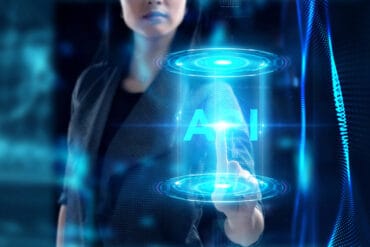
Real-time AI complements Intelligent Automation tools like RPA, creating a powerful synergy that leads to more precise and well-run automation.
A recent study by McKinsey & Company found that intelligent automation can boost productivity by up to 50%! Imagine IT teams freed from routine tasks, empowered to focus on innovation and strategic initiatives. This is the future enabled by the convergence of Intelligent Automation and Real-Time AI. Let’s deep dive into this transformative trend, explore the transformative role of IA, AI and in-depth see the real-world cases enhancing IT workflows.
Intelligent Automation
Intelligent automation brings the strength of Artificial Intelligence (AI) and automation technologies like Robotic Process Automation (RPA) to increase efficiency and improve decision-making in an organization.
Synergizing Intelligent Automation and real-time AI allows IT teams to get free from routine tasks. This enables them to concentrate on innovation, provide valuable services, and pursue strategic initiatives. By concentrating on these demanding areas, organizations can obtain a competitive precedence in the market.
Real-time AI
Real-time AI is a developed form of AI that processes and responds to data right away without needing manual input. It can spontaneously adapt to new conditions and make prompt decisions as conditions advance.
Real-time intelligent tools like chatbots help organizations with valuable insights that increase automation efficiency and speed up response times.
See also: The 2024 State of Automation: Are Leaders Ready to Ditch Legacy Thinking?
Enhancing IT Workflows with Intelligent Automation and Real-time AI
Incorporating Intelligent Automation with Real-time AI can significantly enhance an organization’s digital transformation work and redefine IT workflow. It can help organizations with:
- Refine Resource Management: AI-powered cognizance and automation tools can help IT departments optimize resource allocation and free up resources from monotonous and routine tasks.
- Better Customer Experience: Real-time AI can individualize customer interactions in real time based on factual data, present behavior, and contingent information. Incorporated with automation, this capability results in prompt and appropriate responses to customer questions.
- Improve Decision-Making: Real-time AI facilitates IT systems to examine data sources immediately and make decisions autonomously or with less manual intervention. This promptness is important for responding to performance issues or process failures.
Key Applications
Automated Incident Response
Use case: Real-time IT incident identification and resolution
This use case focuses on using advanced monitoring tools, Machine Learning (ML) algorithms to detect and resolve IT issues in real time, and automated alerting systems to minimize downtime and ensure uninterrupted business operations.
Organizations can enhance their operational resilience, maintain high levels of service availability, and efficiently support their business objectives by implementing a strong real-time identification and resolution infrastructure for IT incidents.
Continuous Deployment and Integration
Use case: Automating real-time code deployment and integration
It includes:
- Automating Builds: To ensure code compiles and runs correctly
- Automated Testing: Perform unit and integration testing to catch bugs early
- Automated code analysis: Maintain code quality through automated analysis
- Rollback Mechanisms: Handle deployment failures efficiently with an automated rollback plan
- Production code deployment: Automated Deployment Scripts to move code to a production environment
Predictive Maintenance
Use case: Real-time monitoring and prediction of hardware failures
Real-time monitoring and prediction of hardware failures minimize system downtime, reduce maintenance costs, and provide a proactive approach to maintaining system reliability. By using advanced analytics and real-time data processing, organizations can notably improve maintenance management and all-inclusive system performance.
Architectural Framework
Let’s take an example of Intelligent Automation with Robotic Process Automation – UiPath is an RPA tool and with the help of Gen AI and Machine Learning models, it acts as an Intelligent Automation. Its architectural framework has three components – UiPath Studio for code development, Robot for running attended and unattended bots and Orchestrator for managing, monitoring and provisioning processes.
By using technologies or tools like this, we can design processes that are not only scalable and flexible but also capable of handling real-time data intake and processing with high efficiency and reliability.
Technological Stack
Examples of real-time AI-powered and Intelligent Automation platforms include:
UiPath: UiPath is a Robotics Process Automation tool that automates routine and monotonous business processes. With the integration of Generative AI and Specialized AI, it can extract any information from documents using Document Understanding with the help of Machine Learning extractors.
Google Gemini: This is a Real-time AI model engineered for understanding languages and executing multimodal reasoning. It can tackle complex problems and inherently support multiple modes of input and output, enabling adaptable variations from any input type to a desired output.
GitHub Co-Pilot: It increases code efficiency and works as a big helping hand in code dev and completion through intelligent autocompletion.
Implementation Challenges and Best Practices
Challenges:
- The availability of experienced professionals with proficiency in both AI and automation technology may be limited.
- Initiating new technologies can lead to employee reluctance and require significant updates to existing processes.
- Integrating Real-time AI and automation tools into already established IT infrastructure can be a complex and tedious process.
- Securing the safety of sensitive data and compliance with privacy regulations is crucial when deploying AI and automation technologies.
Best Practices:
- Upskill existing and new employees by Investing in training programs. Partner with external experts or hire domain specialists to bridge employees’ knowledge gaps.
- Establish clear communication and training for employees to explain the benefits of Intelligent Automation and how it can simplify their professional lives.
- Work with experienced IT professionals and third-party vendors to organize the process well. Use standardized integration conventions and middleware solutions to facilitate trouble-free integration.
- Orchestrate access controls, perform regular security audits, and implement strong security measures, including encryption, to ensure compliance and security.
Conclusion
Real-time AI complements Intelligent Automation tools like RPA, creating a powerful synergy that leads to more precise and well-run automation. This collaboration not only simplifies smooth-run processes but also enables smart decision-making and, in the long run, increases productivity and innovation.
Organizations that successfully integrate Intelligent Automation with Real-time AI can acquire a persisting competitive lead. This synergy drives faster decision-making, improved customer experience, scalability, and predictive maintenance, promotes innovation and operational excellence, and enhances an organization’s ability to respond quickly to market changes and optimize resource management.






























